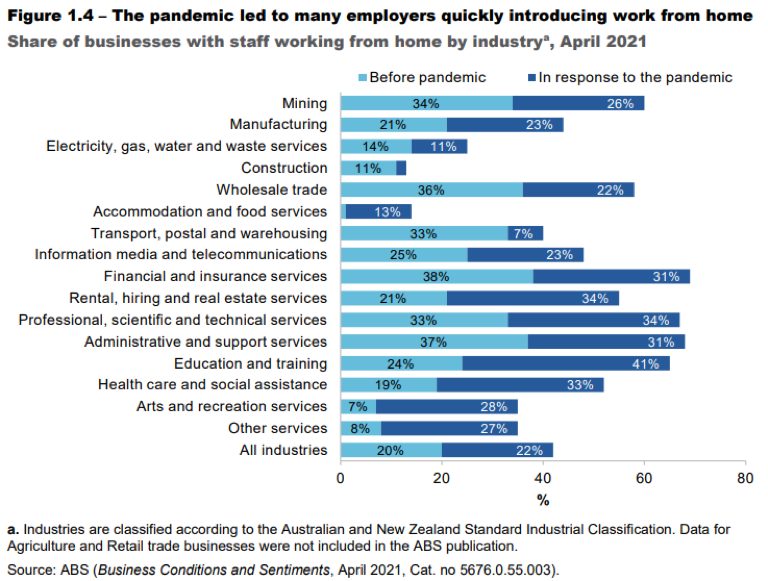
Managing remote teams
Julia Lessing, Director of Guardian Actuarial, offers her top seven tips for effectively managing a team in a remote environment.
With the COVID-19 pandemic in its third year, many actuaries are still working remotely. This means that actuarial managers continue to face the challenge of managing team members who are not in the same location. Most actuaries I’ve spoken to recently are fully or predominantly working from home.
According to a recent Productivity Commission report[1], most Australian workers want to work from home at least some of the time. Three quarters of workers considered themselves to be at least as productive working from home, compared with working in the office. The graph below shows that the proportion of business with staff working from home has doubled in the industries where actuaries are typically found.

New managers, who might be supervising very junior and inexperienced team members, can feel quite unsure about how to strike the right balance between support and micromanagement.
Tips for managing remote teams
So how can managers ensure that junior team members are engaged and productive while working from home?
1. Group check ins for team building and workflow
Just as you did in the office, regular team catchups are important for team members to feel connected. While these catchups might now occur over Teams or Zoom, scheduling weekly workflow catchups, technical lunch and learn sessions and social team building sessions can bring teams together. Sharing industry updates, or even tips, jokes and anecdotes via email or group chat (such as WhatsApp or Teams chat) can also be a great way for leaders to help team members feel connected.
New Actuarial & Financial Risk Manager, Neha Chopra says “I like to catch up with my team on Monday morning to check how much availability they have over the week. This allows me to delegate work effectively and avoids people being overworked.”
![]()
2. 1:1 check ins for review and development
Group check ins can be great for team building and workflow, but are not always the best forum to support individuals, especially new and junior team members.
A one-on-one check in with your junior team members can be less intimidating and more productive. Try checking in via your company chat function, or over the phone or Teams call, to ask what guidance your junior team members need. Setting regular one-on-one sessions and telling your junior team members how they can contact you if they need help can maintain productive work patterns.
Guardian Actuarial Leadership Program participant, Chaturi Bhaskaran says “I find checking in with my team one-on-one every few days is essential for building a connection and offering support. A quick ‘How’s your day?/Anything I can help you with?/What’s your thought process on XYZ?’ over a MS Teams video call (or chat) helps keep my team motivated, connected and on track. I want my team to know that we’re in a partnership and that they can reach out whenever they need.”
![]()
3. Agree how to have ‘quick questions’
When teams work together in the same location it’s easy to see if others are available and ask a quick question. Working remotely means you miss the opportunity to ask a quick question in the lunchroom or kitchen. Knowing how and when to ask a quick question can help junior staff learn and be productive.
Working remotely, technology can play a role to replicate these quick chats via different messenger apps e.g. Slack or Teams. This can help contribute to an open-door policy for quick questions and reduce workflow bottlenecks or junior staff going down ‘rabbit holes’ in workflow. High-performing teams set clear guidelines about how and when to use these tools.
![]()
4. Set clear objectives and tasks
Some managers worry that if they can’t see their teams, they might not know if they are working or not. Across many industries there is a shift from outputs (e.g. set number of hours at my desk) to outcomes (e.g. delivering on what is expected). But how do you know if people are working when you can’t see them at their desk?
Setting clear objectives and deliverables, and for junior team members this often means being clear about tasks, can allow you to feel more confident that your team members know what they need to be doing. An old-fashioned project plan can help with this, or you might like to try a software option such as Asana, Trello, or even the ‘tasks’ function in Teams.
Life Insurance actuary Wei Leng Leow shares this tip: “I find it helpful to use the team task board in MS Teams to track what the team is working on and to manage workload. In addition, it will send notifications as the due date approaches, helping the team to meet the deadlines.”
![]()
5. Apply a manager mindset focussing on trust and support
Great leaders build trust and rapport with their team members. When you have high-performing teams and team members with a strong work ethic, it can be more effective to take a supporter role rather than a warden-type style of management.
Instead of setting catch-ups where you want to check on progress, try being proactive and asking whether your team members need help or guidance.
Actuary and deep thinker Andrew Yin says “I often reflect on what my mentors would do at these times. And I know they would actively share their wisdom, and trust me with the challenges.”
![]()
6. Use clear and creative communication to share your work and whereabouts
When you’re in the office, you can often see at a glance whether someone is at their desk or share a handwritten diagram on your notebook or whiteboard. Working remotely makes these tasks much harder. Clear and creative communication can help when working remotely.
Try using email, shared calendars or your company’s chat functions to let people know when you are away from your desk. Scheduling 15-30 minute catchups in people’s calendars can be a more efficient way of playing phone tag or having a lengthy email trail when you can’t easily tell if someone is at their desk.
Screen sharing through Teams or Zoom can make you feel as though you are both sitting at someone’s computer to look at a spreadsheet or draft slides. Explore how technology can help you creatively share visuals, whether you share photos of your notebook or home office whiteboard (yes, I have two!) via WhatsApp, or I’ve been using a Remarkable[2] electronic notebook, which allows you to email a pdf of images you draw to yourself.
![]()
7. Leverage training to reduce your workload
While on-the-job training can happen organically when people are in the same office, this can be a lot harder when people are working remotely. Leveraging existing or external training, such as online courses, webinars and mentoring, can take the pressure off managers and more efficiently help junior team members build their skills and capabilities.
Start by checking what training your company offers, or buddy up junior team members with more experienced team members for a collaborative learning experience. There is an exploding amount of online training available, including actuarial-specific training on the Actuaries Institute CPD Dashboard.
![]()
Conclusion
It seems that remote working is here to stay. When actuarial managers adopt a supportive managerial mindset and take actions to better support junior team members, such as group team building, one-on-one catchups, setting clear objectives and tasks, encouraging clear communication and leveraging training, they can foster a team environment where all team members are engaged and productive.
What else can you do to better support your remote team members?
|
The original article on which this article is based, Managing remote teams, was first published on Guardian Actuarial in April 2022. It has been modified from its original form for publication here. Reprinted with permission.
|
|
References
|
CPD: Actuaries Institute Members can claim two CPD points for every hour of reading articles on Actuaries Digital.






